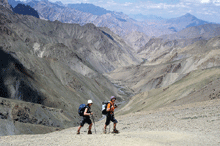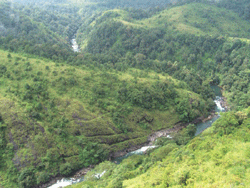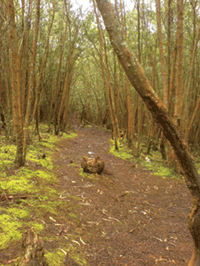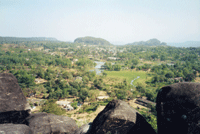India's top 10 trekking trails
With the onset of summer, what better time for hoisting backpacks and disappearing into the wilderness? An avid traveller and trekker, Srinidhi Raghavendra offers a list of the country’s top 10 trekking destinations
 For outdoor enthusiasts and free spirits, trekking/hiking through untrodden ways is the ultimate way to explore nature in its most pristine form. Walking through tangles of green forest, traversing hill and dales, fording every stream in hidden valleys provides rushes of adrenalin, which packaged five-star holidays can never match.
For outdoor enthusiasts and free spirits, trekking/hiking through untrodden ways is the ultimate way to explore nature in its most pristine form. Walking through tangles of green forest, traversing hill and dales, fording every stream in hidden valleys provides rushes of adrenalin, which packaged five-star holidays can never match.
Hardened trekkers are ever ready to swear that Wordsworthian ambles through lonely woods rejuvenate mind, body and soul beyond compare. But although cross-country treks are fast gaining popularity with young India, it’s useful to bear in mind that they require great reserves of energy, stamina, and the ability to rough it in the great outdoors. Far from the creature comforts of starred hotels, smart eateries and glitzy shopping malls, trekking trails deep in the wilds of untamed nature offer exhilarating yet arduous satisfaction.
Hence to make cross-country experiences enjoyable and mishap-free, trekkers need to be well-equipped. A must-have is a sturdy and comfortable backpack which can store clothing, sleeping bags, camping gear, basic cutlery, non-perishable food, water, toiletries, etc. Comfortable hiking boots and a first-aid kit are also a sine qua non. For beginners a one-day hike is a good starting point which with the acquisition of learning-by-doing experience can be extended to half-week and seven-day trekking expeditions. Moreover it’s pertinent to understand that trekking is usually a group activity undertaken only in designated trekking areas.
One of the world’s most popular trekking destinations is located in India — the Himalayas. The lofty, mystical mountains sprawl over 2,560 km covering the states of Jammu and Kashmir, Himachal Pradesh, Uttarakhand (formerly Uttaranchal), Sikkim, Assam, Arunachal Pradesh, Meghalaya and Nagaland and attract legions of trekkers from around the world. Down south away from the imposing Himalayas, there are the alluring trekking trails of the Sahyadri mountain range. The Aravali hills along the western seaboard of India also offer exciting hiking options.
With the onset of summer, what better time for hoisting backpacks and disappearing into the wilderness? An avid traveller and trekker, Srinidhi Raghavendra offers a list of the country’s top 10 trekking destinations.
1. Ladakh: Tso Moriri-Kibber trek
Sited at breathtaking and often mind-bending altitudes of 11,500 ft plus, Ladakh’s stark, icy mountain- scapes offer challenging trekking options. The region attracts over 500,000 domestic and foreign tourists annually, drawn by the district’s towering peaks, wind-swept valleys, icy deserts, and ancient Buddhist monasteries. Several travel agencies offer trekking packages and rent out equipment such as rucksacks, tents, feather jackets, etc against security deposits. Among Ladakh’s most frequented trekking trails is the Tso Moriri-Kibber trek.
The base point for this trek is Korzok village near the Tso Moriri Lake around 240 km from Leh, the admin capital of the district. The Tso Moriri-Kibber trek is of usually ten days duration (including two days of road travel). Trekkers converge at Leh and drive to Tso Moriri lake via Chuma Thang, famous for its bubbling hot springs. Spending the evening at the camp on the banks of the 8 km wide Tso Moriri Lake, the natural habitat of a glory of rare avian species including the bar headed goose, crested grebe, Brahmin duck and brown headed gull, is an ethereal experience.
Day one of the trek entails a five hour hike from Korzok village to the Kyangdam campsite (16,542 ft) skirting Tso Moriri Lake in the south-east direction. The next day’s trek from Kyangdam to Skitpodangsa (16,426 ft) takes four-five hours involving the fording of a river and a vast grassy meadow. From Skitpodangsa to Getpabuzak is a five hour easy walk along the Parangchu river. Trekkers tend to camp on a contiguous slope for the night. From Getpabuzak to Tarang-yokma (17,031 ft) is a five hour trek through carpeted green valleys and panoramic hills.
The trek on the fifth day from Tarangyokma to Karsha Gompa (monastery) or Parang La Base (14,720 ft) is perhaps the easiest stretch — a short walk across a vast meadow and across a shallow, sparkling river. However the next day’s trek from Karsha Gompa to Takkarzong is the most arduous with trekkers having to hike up to the Parang La Pass (18,300 ft). But the path leads to a scenic campsite graced by a majestic waterfall.
Day seven is an expedition from Takkarzong to Thagltak (16,200 ft) along the Parangchu river through a scenic gorge. The camp at Thagltak is sited across the river atop a hill, serviced by a freshwater spring and provides stunning views of verdant valleys. The final day of the trek takes you from Thagltak to Key via Kibber (five hours) through a scenic riverside route. The trek culminates at Kibber village from where trekkers are driven to Kaza, the administrative headquarters of the Spiti valley in Himachal Pradesh.
2. Himachal Pradesh: Solang Valley trek
.gif) Situated at the confluence of the Beas and Manalsu rivers, at the northern end of the Kullu valley, nestles the tourist town of Manali (pop. 4,400). This busy yet charming hill station offers soul-soothing vistas of the majestic Pir Panjal and Bara Bhangal mountain ranges and is the starting point for several popular treks in the state.
Situated at the confluence of the Beas and Manalsu rivers, at the northern end of the Kullu valley, nestles the tourist town of Manali (pop. 4,400). This busy yet charming hill station offers soul-soothing vistas of the majestic Pir Panjal and Bara Bhangal mountain ranges and is the starting point for several popular treks in the state.
My favourite is the Solang Valley hiking trail. The entire trek can be done in four-five days and is a favourite of time-strapped hikers. A mere 17 km beyond Manali, the Solang Valley is at the tail end of the stupendous Pir Panjal range, the largest in the Himalayas. The trek starts off with a short three-hour walk from Solang to Dhundi along the banks of the river Beas offering spectacular views of the Indrasan (19,990 ft) and Deo Tibba (19,687 ft) peaks en route. From Dhundi hikers proceed up steep slopes to reach Bakkar Thach, the high altitude grazing fields of local shepherds. From here the trek to Beas Kund, a vast plateau surrounded by ashen Himalayan peaks, is a short climb up a ridge. Weather permitting, trekkers camp at Beas Kund or return to Bakkar Thach. On day five is the return trek to Solang Valley base camp.
3. Garhwal: Valley of flowers
Showpiece of the himalayan state of Uttarakhand, 500 km northeast of Delhi, the Valley of Flowers (VoF) where nature dazzles, is one of the world’s most spectacular trekking destinations. It’s a constituent unit of the Garhwal region famed for its scenic valleys, fresh water streams and exotic flora and fauna. Sprawled across 87.50 sq km against a canvas of shimmering white mountains, the valley of flowers and the neighbouring Nanda Devi National Park was declared a World Heritage Site by Unesco in 2005.
.gif) The arduous trek to VoF begins at Govind Ghat, from where it takes about seven hours to reach Ghangaria, a pilgrimage centre of devout Sikhs. Sited 9,760 ft above sea level, Ghangria is a serene and tranquil location.
The arduous trek to VoF begins at Govind Ghat, from where it takes about seven hours to reach Ghangaria, a pilgrimage centre of devout Sikhs. Sited 9,760 ft above sea level, Ghangria is a serene and tranquil location.
From Ghangaria to the Valley of Flowers is a five hour hike. Purchase of a camera ticket (Rs.100) to photograph the blossoms in the 10x4 km valley is mandatory — a worthwhile investment as the landscape is flush with thousands of flower blooms and blossoms in the summer months of July-September. A bio-diversity hotspot and protected area, camping is prohibited in the valley. Those interested in returning to view floral nature in maximum glory need to camp at Ghangaria. From Ghangaria the return to Govind Ghat is also seven hours. At Govind Ghat, public buses connect with Haridwar and Delhi.
4. Sikkim: Dzongri trek
Way up in the clouds in the north-east is the charming stamp-sized Himalayan state of Sikkim (pop. 540,000). A topographic collage of snow-capped Himalayas, mist-shrouded valleys sliced by the tempestuous river Teesta, lush green wilderness, colourful Buddhist gomphas (monasteries) perched atop rocky heights, meadows carpeted with heather and wild flowers, and frozen glaciers, over the past two decades Sikkim has emerged as a preferred destination of trekkers from around the country.
One of the most stimulating treks in Sikkim is the Dzongri trail to the south west. Sited at a breathtaking altitude of 13,440 ft, the Dzongri trail is bounded by several Himalayan peaks including the mighty Kanchenjunga.
.gif) The Dzongri trail trek begins at Yuksom, a small town in west Sikkim, with an 18 km steep uphill walk to Tsokha (9,760 ft). Budget six-seven hours to negotiate this stretch through cool, moss draped pine and oak forests. The toughest part of the trail is a 70 degree uphill ascent from the banks of Prek Chu river to Bakhim and from there to Tsokha through a natural meadow of magnolia and rhododendrons.
The Dzongri trail trek begins at Yuksom, a small town in west Sikkim, with an 18 km steep uphill walk to Tsokha (9,760 ft). Budget six-seven hours to negotiate this stretch through cool, moss draped pine and oak forests. The toughest part of the trail is a 70 degree uphill ascent from the banks of Prek Chu river to Bakhim and from there to Tsokha through a natural meadow of magnolia and rhododendrons.
The next day’s trek from Tsokha towards Dzongri, includes negotiating a steep ascent through a labyrinth of pine forest. A five-six hour walk through dense forest cover canopying 400 flower and orchid species, takes campers to Phethang. In a cosy log cabin they can rest their sore feet while roasting their thoughts over a crackling camp fire, before resuming the hike to Dzongri.
Given its high-altitude location, Dzongri offers scarce vegetation, only shrubs and bushes. Nevertheless a minimum two day stay is recommended for rest and recovery. Meanwhile visit Dabla Khang which offers breathtaking vistas of Himalayan peaks. Return to Yuksom is a reversal of the same route and takes two days via Phethang and Tsokha.
5. Nagaland: Dzukhu valley
Accessible via a high 8,640 ft pass shrouded in dense forest, a short trek (two-five days) through the Dzukhu valley in the north-eastern state of Nagaland (pop. 1.9 million) is a refreshing outdoor experience. Local guides can be hired at Kohima to guide trekkers through alpine meadows famed for the state’s dwarf bamboo trees which turn white during the winter months.
The more adventurous can hike up to the cloud-layered summit of Mt. Japfu (10,058 ft), which hosts the world’s tallest rhododendron (68 ft).
6. Rajasthan: Aravalis
Among the oldest mountain ranges of the Indian peninsula, the Aravali hills traverse the states of Rajasthan and Gujarat, offering visitors a blend of adventure options including trek and camel safaris. Trekking trails in the Aravalis tend to be short and seldom extend beyond four-five hours. But they provide opportunities to take in an array of pilgrim centres. One of the most famous Aravali trails leads to the Rashtrasena Mata temple, atop a rocky cliff which rises 500 ft into the sky. From this vantage point panoramic vistas of stark desert landscapes attract attention. Moreover, in the natural valleys one can hit trails which skirt numerous meadows and crystal clear lakes.
Another delightful trekking trail deep within the Aravali range is the climb to Kumbhalgarh Fort. Sited about 90 km from Udaipur, off the Udaipur-Pali-Jodhpur road, the challenging ascent to the 15th-century Kumbhalgarh fort affords stunning vistas of parched desert moonscapes. Hiking up the rugged path to the fort is truly enjoyable, and worth the effort.
Given Rajasthan’s hot, dry summers, it’s advisable to trek in the Aravalis during the winter months (November-February).
7. Karnataka: Western ghats
The western ghats aka Sahyadris in south-western India are not far short of the Himalayas in terms of unbridled natural beauty and rich bio-diversity. The Western Ghats constitute a 1,600 km ridge from the north to south along the western edge of the Deccan Plateau all the way down to Kanyakumari. Over 60 percent of the Ghats fall within the state of Karnataka. One of the world’s eight ‘biodiversity hotspots’, the Ghats host over 4,800 species of plants, 139 mammals, 512 bird and 179 amphibian species.
.gif) Although the craggy Ghats offer multiple choices in terms of trekking options, my favourite is the hike to Kudremukh peak. Three important rivers, Tunga, Bhadra and Nethravathi originate in Kudremukh (‘horse face’ because the peak projects an equine silhouette). Sited 95 km south-west of the coffee rich Chikmaglur district, Kudremukh (6,440 ft) is the second highest peak in Karnataka and stands head and shoulders above contiguous hills, chained together by deep valleys and steep ravines. The peak and surrounding areas retain much of their natural beauty, characterised by lush forests interspersed with rivers, grassy slopes and murmuring brooks.
Although the craggy Ghats offer multiple choices in terms of trekking options, my favourite is the hike to Kudremukh peak. Three important rivers, Tunga, Bhadra and Nethravathi originate in Kudremukh (‘horse face’ because the peak projects an equine silhouette). Sited 95 km south-west of the coffee rich Chikmaglur district, Kudremukh (6,440 ft) is the second highest peak in Karnataka and stands head and shoulders above contiguous hills, chained together by deep valleys and steep ravines. The peak and surrounding areas retain much of their natural beauty, characterised by lush forests interspersed with rivers, grassy slopes and murmuring brooks.
8. Kerala: Silent Valley
The beauteous unspoiled forests of Silent Valley, situated in the south-western seaboard state of Kerala, are a trekker’s dream. At an altitude of 6,800 ft above sea level and encompassing 90 sq km, the Silent Valley National Park hosts an extraordinary species of wildlife including the lion tailed macaque monkey, king cobra, leopard, Malabar squirrel, Nilgiri langur and the Malabar laughing thrush. Discovered in 1847 by British botanist Robert Wight, it is one of the last untrammeled tracts of the Western Ghats. Its tropical evergreen forests and undulating hills are a perfect habitat for nature lovers, eco researchers and trekkers.
 Designated an ecologically fragile region and targeted for conservation, trekking in the Silent Valley is strictly monitored by the Kerala state government’s forestry department. Trekkers must procure several permits from the forest department office at Mukkali or from the wildlife warden at Mannarkkad. A guide-cum-cook accompanies hikers through approved trails. Five camping sites have been established by the forestry department and trek routes have to be planned accordingly. A typical four-day trek starts from Mukkali through Sairandhiri-Poochipara peak-Walakkad -Sispara, culminating in Anginda.
Designated an ecologically fragile region and targeted for conservation, trekking in the Silent Valley is strictly monitored by the Kerala state government’s forestry department. Trekkers must procure several permits from the forest department office at Mukkali or from the wildlife warden at Mannarkkad. A guide-cum-cook accompanies hikers through approved trails. Five camping sites have been established by the forestry department and trek routes have to be planned accordingly. A typical four-day trek starts from Mukkali through Sairandhiri-Poochipara peak-Walakkad -Sispara, culminating in Anginda.
Getting there. Silent Valley is sited in north-eastern Palakkad district, Kerala. The base point town is Mannarkkad (66 km). Entry fee per visitor is Rs.20.
9. Tamil Nadu: Kodaikanal
 The southern state of Tamil Nadu is dotted with quaint, pretty hill stations developed by the British. Among the most attractive of these cooler climes is Kodaikanal. Set amidst the gently sloping Palani hills, this pleasing resort offers some of the best nature trails apart from hand-gliding, angling and golfing options.
The southern state of Tamil Nadu is dotted with quaint, pretty hill stations developed by the British. Among the most attractive of these cooler climes is Kodaikanal. Set amidst the gently sloping Palani hills, this pleasing resort offers some of the best nature trails apart from hand-gliding, angling and golfing options.
A trekkers’ favourite is the seven-hour, 18 km Periyakulam-Adukkam-Kodaikanal trek. Starting in Periyakulam village, the trail ambles through gentle slopes skirting the roaring Chezhunghu river. After crossing the river, trekkers pass through groves of silk cotton trees and several coffee plantations leading to deciduous forest. Here the slopes become steep and after a gruelling climb via twists and turns, Adukkam village is in sight. The round trip back from the village to Kodaikanal is the most challenging stretch of the trek, along a steep ridge and a passage through vast grasslands and savannah forest.
Another recommended nature ramble is the Kumbakarai-Vellagavi-Kodaikanal trail. This five-hour, 9 km trail is the actual path which residents of Vellagavi village traverse when they come to the hill station. It starts at the picturesque Kumbakarai falls, and proceeds west along the Vannathiodai river through thick deciduous forest.
The initial leg of the trek is a gentle downhill descent to the river, after which the path becomes steep skirting the gushing Vellagaviar river all the way up to the village. Though far removed from Kodaikanal and without an all-weather road, Vellagavi is a well planned rural habitation with paved streets and a quaint Muruga Temple. The trek ends at Dolphin’s Nose, a rock formation amidst pear plantations.
NB: Forest department permission is required to trek in the reserved forests of Kodaikanal (Tel: 04542- 241675).
10. Madhya Pradesh: Pachmarhi
 The largest of the 29 states of the Indian Union, the huge geographical sprawl (443,446 sq. km) of Madhya Pradesh offers numerous trekking opportunities amid its richly forested hills and national parks. The pick of them are centred around the hill station of Pachmarhi, 3,500 ft above sea level. Sited in the heart of the towering Satpura range, Pachmarhi is 200 km from the state’s capital Bhopal. Its quiet and sleepy hiking trails meander through and around sal and bamboo forests, up steep hills and into pleasant valleys, crossing several brooks and streams.
The largest of the 29 states of the Indian Union, the huge geographical sprawl (443,446 sq. km) of Madhya Pradesh offers numerous trekking opportunities amid its richly forested hills and national parks. The pick of them are centred around the hill station of Pachmarhi, 3,500 ft above sea level. Sited in the heart of the towering Satpura range, Pachmarhi is 200 km from the state’s capital Bhopal. Its quiet and sleepy hiking trails meander through and around sal and bamboo forests, up steep hills and into pleasant valleys, crossing several brooks and streams.
Most trails can be completed within a day and of the lot, the trek to Priyadarshini point, the highest in the Satpura range, is the most delightful. This is the spot where Pachmarhi was discovered by Captain James Forsyth in 1857 and it offers awesome views of the town and surrounding hills. A 10 km trek through the forest to the Shaivite Mahadeo cave temple is spiritually elevating .